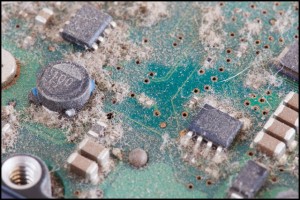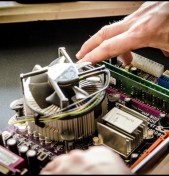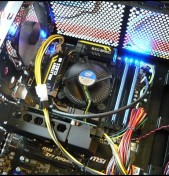 There are a lot of electronic components inside your desktop computer, and they all have two things in common: They make heat, and they don’t like being hot. Ask anyone behind the counter at a computer repair shop to name the number one culprit for hardware failure, and they’ll always say too much heat. Today’s desktop computers are amazingly durable, but excessive heat can shorten their lifespan by a lot.
There are a lot of electronic components inside your desktop computer, and they all have two things in common: They make heat, and they don’t like being hot. Ask anyone behind the counter at a computer repair shop to name the number one culprit for hardware failure, and they’ll always say too much heat. Today’s desktop computers are amazingly durable, but excessive heat can shorten their lifespan by a lot.
Keeping your computer cool is easy and safe enough for anyone to try. In most cases, the techniques don’t require any cash outlay, and they can be accomplished in a few minutes. Here’s a list of the Top 5 ways to keep your computer cool:
Increase Circulation Around the Case
Give your computer more breathing room. It’s tempting to put your desktop computer inside a cabinet, or stack things on top of it or around it. That’s a bad idea. Computers rely on circulating fans to cool the interior components, and if they can’t draw cool air in and blow hot air out, overheating is almost a certainty. In general, you should leave two or three inches clearance on every side of the case. If possible, the front and back of the case should be unobstructed.
If your computer is inside a cabinet, you should leave the door open while it’s in use. If you continuously recycle the air inside a small enclosure, the temperature can climb rapidly, and a visit to your computer repair shop can’t be far behind.
Keep the Case Covers On
There is a popular misconception that removing the side panels from your computer’s case will make it run cooler. There are two reasons why this doesn’t work. First, it exposes all the components to more dirt and dust than normal. When components gather a film of dust, it acts as insulation and diminishes the amount of cooling supplied by air circulation.
The second reason this doesn’t work is that computers are designed to work with the side panels on. Cool air is drawn in at particular locations, and it passes over critical components at a predictable rate. With the panels off, the path of the cooling air might be compromised, and some components left with no cooling because the air exits the case before it reaches them.
Move the Computer
If your computer runs hot all the time, or picks up an extreme amount of dust, you should probably consider moving it to another location. Many people locate their desktop computer on the floor next to their desk, and that can lead to more dust than usual being drawn into the fans. Try moving it around that desk to a more suitable area, or if that fails, you should consider moving the computer to another desk.
Heat and dust are not the only two factors to worry about. Computers don’t like damp areas. If you’re using your computer in a basement in order to take advantage of the cool temperatures, you might be solving one problem only to cause another one. Computers need cool, dry air to function properly, and dampness makes dust accumulate in the case even faster.
Clean Out the Dust
If dust accumulates inside your computer, it can lead to hotter temperatures in two ways. The coating of dust acts as an insulator, so whatever cooling air is available doesn’t get a chance to do its job. Your fans will eventually become caked with dust, and that slows them down and makes them less efficient. It can even make them grind to a halt. Many computer users bring their computers to a computer repair shop to have the fans replaced, only to discover that they work fine once the technician blows the dust off of it.
You can use a dust cloth or a vacuum on the inlet and exhaust grilles on the outside of your computer’s case. You need to be more careful when you open up the case and clean inside. A computer repair shop uses compressed air to blow dust from circuit boards for a reason. Static electricity can fry a circuit board in an instant, which will turn a simple cleaning chore into an expensive computer repair. When you have your computer case open for cleaning, keep one hand on the metal frame at all times to stay grounded, and avoid brushing up against any interior components.
Have Your Computer Repair Shop Upgrade the CPU Fan
If your computer still runs very hot, even though it’s placed in an appropriate location and is free of dust, consider taking it in to your local computer repair shop for a CPU fan upgrade. The Central Processing Unit produces the most heat inside the computer’s case, and it’s the most likely component to fail from overheating. Most CPUs have a cooling fan installed right on top of them, but it’s barely big enough to get the job done. Upgrading to a more powerful fan is an inexpensive way to improve performance, and the repair only takes a few minutes.
Extend the Life of Your Computer
You wouldn’t drive your car for years with the high temperature indicator light on. There’s no reason to ignore your computer’s need for cooling, either. Keep your desktop computer happy by locating it in an appropriate spot, give it regular cleanings, and you’ll add years of trouble-free service to its life!
 Over 50,000 customers served!
Over 50,000 customers served!




